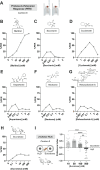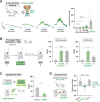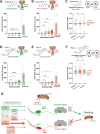Artificial sweeteners differentially activate sweet and bitter gustatory neurons in Drosophila
- PMID: 40594804
- PMCID: PMC12216712
- DOI: 10.1038/s41598-025-08467-4
Artificial sweeteners differentially activate sweet and bitter gustatory neurons in Drosophila
Abstract
Artificial sweeteners are highly sweet, non-nutritive compounds that have become increasingly popular over recent decades despite research suggesting that their consumption has unintended consequences. Specifically, there is evidence suggesting that some of these chemicals interact with bitter taste receptors, implying that sweeteners likely generate complex chemosensory signals. Here, we report the basic sensory characteristics of sweeteners in Drosophila, a common model system used to study the impacts of diet, and find that all noncaloric sweeteners inhibited appetitive feeding responses at higher concentrations. At a cellular level, we found that sucralose and rebaudioside A co-activated sweet and bitter gustatory receptor neurons (GRNs), two populations that reciprocally impact feeding behavior, while aspartame only activated bitter cells. We assessed the behavioral impacts of sweet and bitter co-activation and found that low concentrations of sucralose signal appetitive feeding while high concentrations signal feeding aversion. Finally, silencing bitter GRNs reduced the aversive signal elicited by high concentrations of sucralose and significantly increased sucralose feeding behaviors. Together, we conclude that artificial sweeteners generate a gustatory signal that is more complex than "sweetness" alone, and this bitter co-activation has behaviorally relevant effects on feeding that may help flies flexibly respond to these unique compounds.
© 2025. The Author(s).
Conflict of interest statement
Declarations. Competing interests: The authors declare no competing interests.
Figures




Similar articles
-
Activation of the sweet taste receptor, T1R3, by the artificial sweetener sucralose regulates the pulmonary endothelium.Am J Physiol Lung Cell Mol Physiol. 2018 Jan 1;314(1):L165-L176. doi: 10.1152/ajplung.00490.2016. Epub 2017 Sep 28. Am J Physiol Lung Cell Mol Physiol. 2018. PMID: 28971978 Free PMC article.
-
Molecular characterization of gustatory second-order neurons reveals integrative mechanisms of gustatory and metabolic information.Elife. 2025 Jul 9;13:RP100947. doi: 10.7554/eLife.100947. Elife. 2025. PMID: 40631860 Free PMC article.
-
Bitter Sensing Protects Drosophila from Developing Experience-Dependent Cocaine Consumption Preference.J Neurosci. 2025 Jul 2;45(27):e1040242025. doi: 10.1523/JNEUROSCI.1040-24.2025. J Neurosci. 2025. PMID: 40456609
-
Signs and symptoms to determine if a patient presenting in primary care or hospital outpatient settings has COVID-19.Cochrane Database Syst Rev. 2022 May 20;5(5):CD013665. doi: 10.1002/14651858.CD013665.pub3. Cochrane Database Syst Rev. 2022. PMID: 35593186 Free PMC article.
-
Systemic pharmacological treatments for chronic plaque psoriasis: a network meta-analysis.Cochrane Database Syst Rev. 2021 Apr 19;4(4):CD011535. doi: 10.1002/14651858.CD011535.pub4. Cochrane Database Syst Rev. 2021. Update in: Cochrane Database Syst Rev. 2022 May 23;5:CD011535. doi: 10.1002/14651858.CD011535.pub5. PMID: 33871055 Free PMC article. Updated.
References
-
- Pearlman, M., Obert, J. & Casey, L. The association between artificial sweeteners and obesity. Curr. Gastroenterol. Rep.19, 64. 10.1007/s11894-017-0602-9 (2017). - PubMed
-
- Schiano, C. et al. Soft drinks and sweeteners intake: possible contribution to the development of metabolic syndrome and cardiovascular diseases. Beneficial or detrimental action of alternative sweeteners? Food Res. Int.142, 110220. 10.1016/j.foodres.2021.110220 (2021). - PubMed
MeSH terms
Substances
LinkOut - more resources
Full Text Sources

